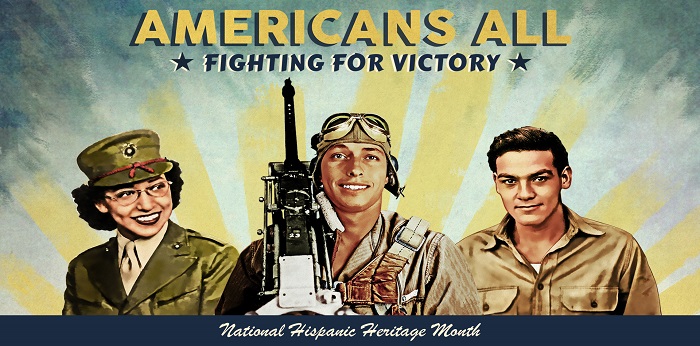9/24/2020 8:00:00 AM
The Minnesota Department of Veterans Affairs (MDVA) proudly recognizes Latino Heritage Month from September 15 to October 15 to celebrate the history, achievements, contributions, and diversity of the Latino community.
As shared by Gov. Walz in his 2020 Proclamation of Latino Heritage Month, September 15 marks the anniversary of independence for several Latin American countries including Costa Rica, El Salvador, Guatemala, Honduras, and Nicaragua. Mexico celebrates its independence September 16 and Chile on September 18.
In Minnesota, Hispanic/Latino Veterans comprise 1.8 percent of our Veteran population. In 2017, we shared about the historic moment when Minnesota had two Hispanic Commanders at the same time: Mick Aguirre for Disabled American Veterans (DAV) and Joe Mauricio of the Veterans of Foreign Wars (VFW) – read on MDVA’s blog.
Did you know? Facts from the U.S. Department of Veterans Affairs, Center for Minority Veterans
For celebration messages and to get connected to Veteran and community resources and educational tools, check out these sites.
The Diversity, Equity and Inclusion (DEI) Office at the Minnesota Department of Veterans Affairs strives to create and support a workplace where all employees feel they belong. To ask questions, discuss concerns, or give any suggestions for making the workplace more inclusive, please contact the Director of DEI Valerie Klitzke by phone: 651-219-0176 or email: diversity.MDVA@state.mn.us.
 Image provided by the Defense Equal Opportunity Management Institute
Image provided by the Defense Equal Opportunity Management Institute
Biographies – From left to right
Sergeant Consuelo Mary Hartsell – One of seven children, she grew up in Rawlins, Wyoming, the only Latino family in town.
In the fall of 1944, Hartsell and her sister, Juniata enlisted in the U.S. Marine Corps Women's Reserve. (Four of the Macias children eventually became Marines.) The sisters were sent to boot camp at Camp Lejeune in North Carolina, the only sisters and the only Latinas in the camp. Both were assigned office jobs at the Depot of Supplies of the 1st Marine Division in San Francisco. Hartsell was assigned a desk job overseeing supplies shipped to and from overseas.
She left the service in 1946. She was awarded American Campaign and World War II victory medals, as well as recognition for her honorable service.
Staff Sergeant Ladislao “L.C.” Castro – The assistant engineer and waist door .50 caliber gunner on a B-24 Liberator bomber named “T-Bar” of the "Flying Eightballs" in the 506th Squadron, 44th Bombardment Group (Heavy), 8th Air Force.
On March 18, 1944, as Castro was completing his final 21st mission prior to deploying home, the T-Bar was shot down after a raid on the southern German city of Friedrichshafen near the Swiss border. Castro parachuted from his crippled plane into German occupied France. While the rest of the 10-man crew were captured, Castro evaded capture until discovered by French farmers.
The farmers took him to the French Underground, the French resistance movement. He was then taken to Amiens, France where he was hidden with 16 other airmen for five months until the city was liberated by the Canadian Army on September 1st, 1944. But, Castro’s service did not end there; he was recalled to active duty as an Air Force mechanic during the Korean War and later served for 22 years as a civil servant at Bergstrom Air Force Base at Austin, Texas, the same place he enlisted to fight in World War II.
Corporal Julius Casarez – “My brother told me that if I enlisted sooner rather than later, I could pick where I wanted to be stationed,” he shared in an interview. Little did he know that when he enlisted, the Japanese were only a few days away from bombing Pearl Harbor, and he’d be forced to go where the Army told him to go.
In June of 1942, Casarez was sent via Africa to India, to serve as part of the 703rd Special Forces, a machine-gun battalion. In July, they crossed into India, which was being bombed. Private Casarez and the rest of his unit served there a few months as machine gunners. Finally, they were sent over the Himalaya Mountains. A month later the Japanese chased the Army unit out of China, where they’d been stationed.
Now in Burma, part of Casarez’s unit's duties were to protect the bridges that had recently been built as a way of transporting supplies to Army units at the front. Casarez's unit would shoot at the Japanese planes that would try to bomb the bridges. Casarez finished out the war in the China-Burma-India Theater. He’d spent close to four years fighting not only people, but the time and the elements.
Finally, word came in 1945 that he could go home. However, the unit couldn’t arrange transportation out of the area. After about a month, his captain finally told the troops to, "get out of here the best way you can." Casarez hitchhiked across China, until he was able to locate an allied airstrip where, eventually, he was one of the lucky few able to take an airplane home. Corporal Casarez was discharged in November of 1945.